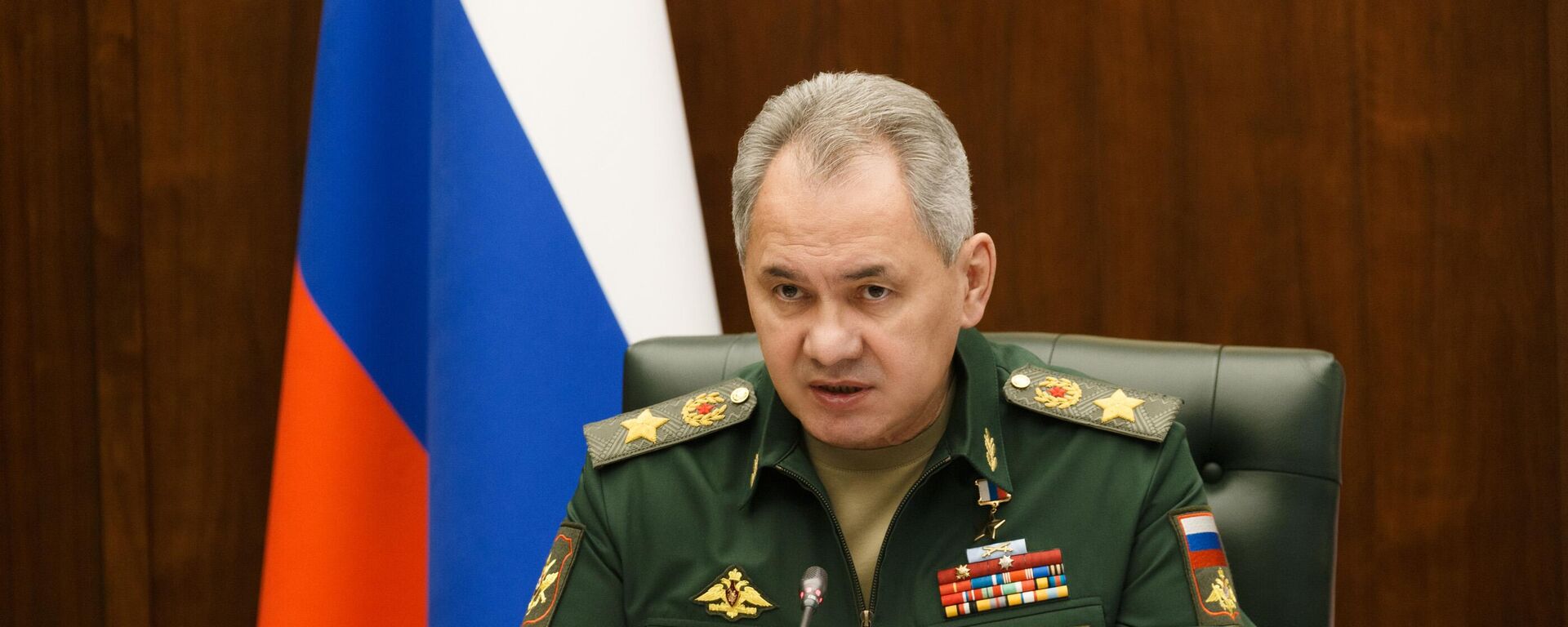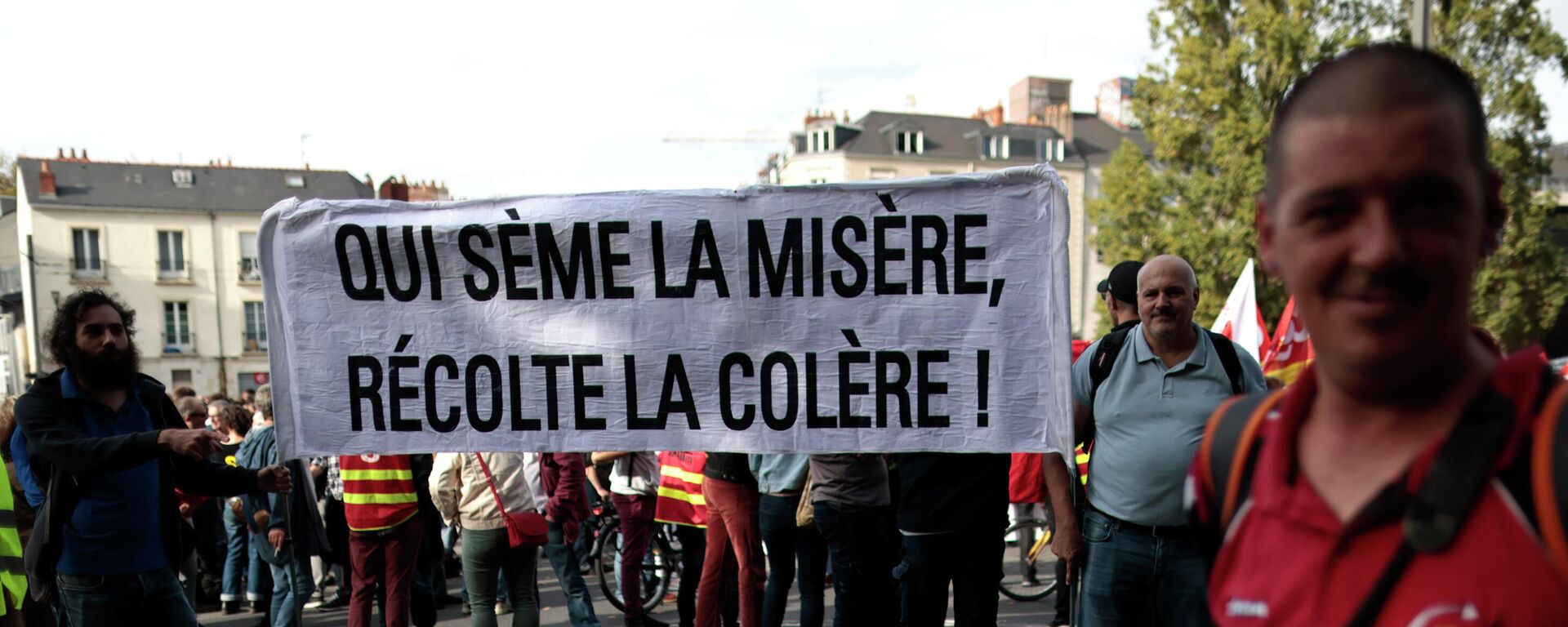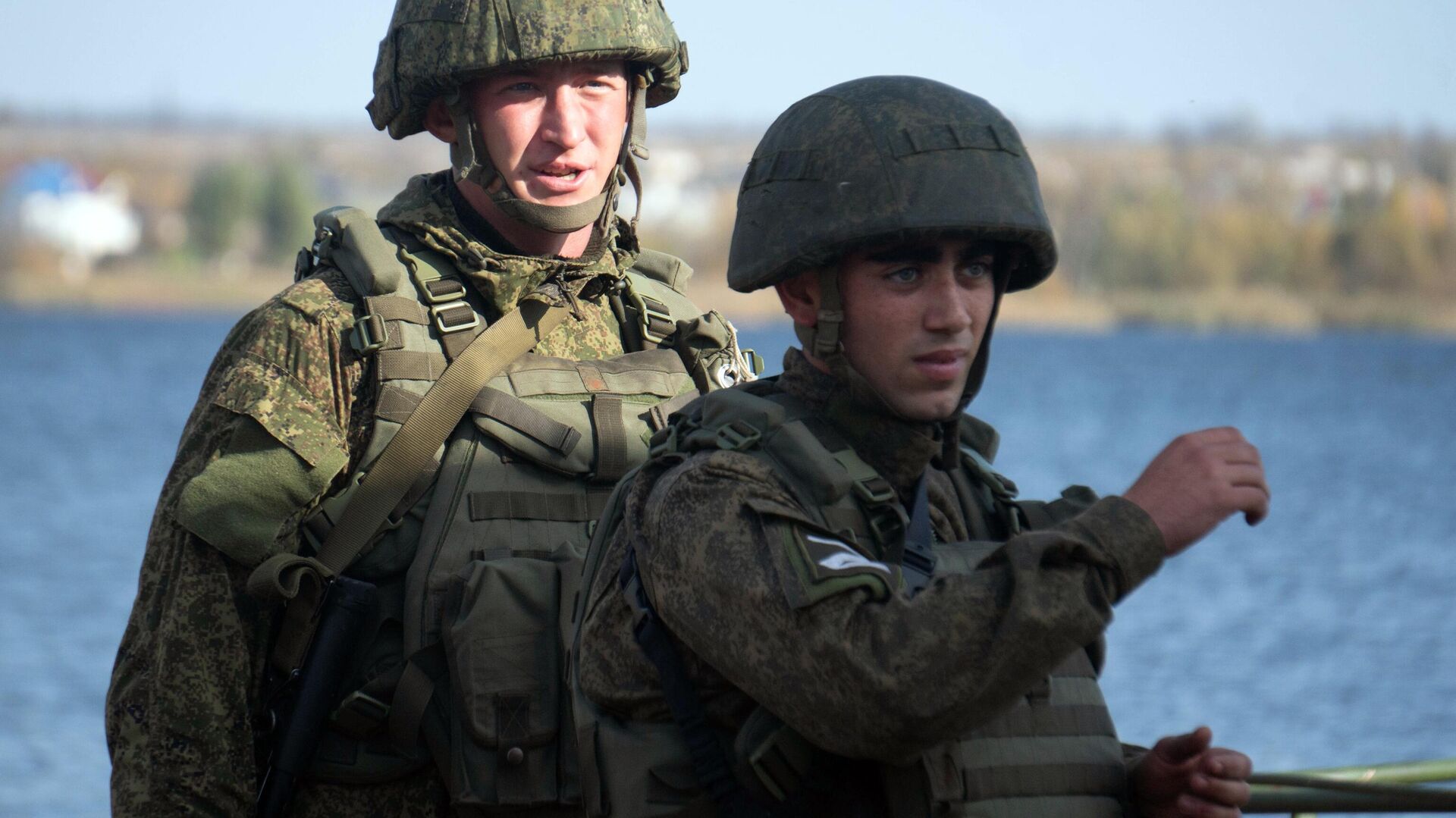https://sputnikglobe.com/20221109/3-reasons-russia-is-withdrawing-from-part-of-kherson-1103951287.html
3 Reasons Russia is Withdrawing From Part of Kherson
3 Reasons Russia is Withdrawing From Part of Kherson
Sputnik International
General Sergei Surovikin announced Wednesday that Russian forces are withdrawing from the right bank of the Dnepr River and forming defensive positions on its... 09.11.2022, Sputnik International
2022-11-09T18:09+0000
2022-11-09T18:09+0000
2022-11-09T18:45+0000
russia's special operation in ukraine
ukraine
russia
kherson
nato
moscow
sergei surovikin
sergei shoigu
https://cdn1.img.sputnikglobe.com/img/07e6/0b/09/1103950964_0:161:3071:1888_1920x0_80_0_0_ed238eb236b102b3226584f3b85761f0.jpg
Russian General Sergei Surovikin never made any secret of the “very difficult” situation that had developed on the front in Kherson. On October 18, only 10 days after being appointed commander of all Russian forces in Ukraine, the officer stressed that the NATO puppet masters pulling the Ukrainian Army’s strings had long demanded “offensive operations in the Kherson direction” to push Russian forces from Kherson’s right bank, “without any regard for casualties, both among the Armed Forces of Ukraine and among the civilian population.”The commander pointed out that HIMARS strikes had already damaged the Antonovsky Bridge linking Kherson’s left and right banks across the Dnepr, as well as the nearby Kakhovskaya hydroelectric power station, complicating the transport situation and causing problems with food and electricity deliveries. On top of that, Surovikin said, Moscow had intelligence that Kiev was planning to launch a massive missile attack on the Kakhovskaya Dam, and indiscriminate missile and artillery strikes against the city of Kherson and its population of 180,000+ residents.“Our further plans and actions regarding the city of Kherson will depend on the emerging military-tactical situation,” Surovikin said at the time, emphasizing that Russia’s strategy would proceed from the need to preserve the lives of both civilians and Russian military personnel. He did not rule out “difficult decisions.”Tactical NecessityOn Wednesday, the moment for such a decision came. Speaking to Russian Defense Minister Sergei Shoigu and once again reiterating the threat of a Ukrainian attack on the Kakhovskaya Dam, Surovikin warned that “there will be an additional threat to the civilian population and of the complete isolation of our group of forces on the right bank of the Dnepr. Under these conditions, the most appropriate option will be to establish defense along the barrier line of the Dnepr River.”Shoigu agreed with Surovikin’s assessment, reiterating the importance of preserving the lives of both military personnel and noncombatants.Threat to CiviliansSurovikin’s concerns about the danger posed to Kherson’s civilian population are not academic. In the opening stages of Russia’s military operation this spring, thousands were killed or injured in Mariupol, Popasnaya, Volnovakha and other urban locations after Ukrainian forces and neo-Nazi battalions dug in, often deliberately in civilian areas, hiding in or near apartment blocks, shopping centers, schools, kindergartens, and even hospitals, to lure Russian forces into bloody street battles, and receive a convenient pretext to accuse Moscow of war crimes anytime a civilian building was damaged or destroyed.By withdrawing forces from the right bank of the Dnepr, Russian forces have signaled their rejection of this costly and bloody strategy. Over the past three weeks, as Ukrainian forces amassed troops near Kherson and intensified shelling of the city, a large-scale evacuation of civilians was kicked off. In his remarks Wednesday, Surovikin reported that over 115,000 people had been evacuated, taken to Crimea and other areas deeper inside Russia.The military’s strategy of evacuation and the creation of a defensive line that can be easily secured appears to be aimed at showing that Russia is not interested in "pyrrhic victories," and that Moscow will not succumb to efforts by NATO and its clients in Kiev to drown the region in blood, kill tens of thousands, and trap Russia in a hopeless strategic and tactical situation from which it would be nearly impossible to escape.In the run-up to Wednesday’s announcement, Ukrainian commanders made no secret of their assessment of the situation. On October 29, Ukrainian military intelligence chief Kyrylo Budanov predicted that amid the concentration of Ukrainian forces, NATO mercs, and heavy weapons near Kherson, the “liberation” of the city wouldn’t take place “without a fight,” but be preceded by the cordoning off of the city and the isolation of Russian forces, followed by battles to gradually grind them down. The strategy is familiar to historians of the Second World War on the Eastern Front, which featured the heavy use of pincers to encircle troops, leave them without supplies, and gradually close the noose to eliminate them or take them prisoner.In his remarks last month, Budanov even suggested that Russia might sabotage the Kakhovskaya Dam to try to slow down Ukrainian forces, apparently forgetting that terrorist attacks against civilian infrastructure was more Kiev and the West’s forte (the recent attacks on Nord Stream, the Crimean Bridge, and Sevastopol Bay serving as but a few examples).Russia’s Strategy in Historical ContextThe Russian military’s decision was obviously a “difficult,” forced measure, as Surovikin openly stated in his remarks Wednesday.In both the strategic and historical contexts, the pullout to the left bank of the Dnepr River could be said to be based on a broader interest – winning the "proxy war" that the West has declared on Russia, not winning a single battle. During the Great Northern War against Sweden of 1700-1721, the French invasion of Russia in 1812, and the Great Patriotic War of 1941-1945, commanders pulled back forces dozens or even hundreds of kilometers when necessary, but never lost sight of the strategic goal.In the Ukrainian security crisis, unleashed by the US and the EU in 2014, time appears to be on Russia’s side, with Kiev and its Western backers facing an increasingly grim series of economic and energy crises, and Western capitals from Washington to Berlin signaling exhaustion with Kiev, and expressing growing hesitation to support the bottomless pit of weapons and cash that Ukraine has become.US and European media have issued report after report detailing how NATO is literally running out of weapons to send to Ukraine. Meanwhile, capitals across Europe, including economic and political powerhouse Germany, have been overrun with cost of living protests sparked largely by Brussels’ move to slap restrictions on Russian energy.The US, which has committed $60 billion of the estimated $100 billion in military and economic support sent to Kiev over the past eight months, just held its most highly-contested midterm elections in decades, with Republicans poised to take the House, and wrangling with Democrats for control of the Senate. Last month, Republican House Minority Leader Kevin McCarthy warned that there would be no “blank check” for Ukraine in a GOP-controlled House.The Trump wing of the GOP has been even more adamant, with Representative Marjorie Taylor Greene stressing last week that “not another penny will go to Ukraine” under the Republicans, who will instead focus Washington’s energy and resources on the US’ porous border with Mexico. Only time will tell whether the politicians will make good on their promises, or even be allowed to do so by America's powerful deep state interests.Whatever happens, in a situation where Russia has the energy and food resources to survive the coming winter, and a seemingly better chance to preserve the political wherewithal to ride out the crisis, it will ultimately be up to Kiev's Western sponsors to decide whether to continue the strategy of exchanging tactical gains for strategic losses, or to finally push its clients to come to the negotiating table and address Russia's fundamental security concerns.More than 150 years after being written, these words have not lost their relevance.
https://sputnikglobe.com/20221109/commander-of-russian-forces-in-ukraine-delivers-report-to-defense-minister-on-special-op-1103943922.html
https://sputnikglobe.com/20221021/russian-forces-help-people-of-kherson-evacuate-across-dnepr-amid-ukraine-strikes-1102494156.html
https://sputnikglobe.com/20221107/quarter-of-europeans-on-the-brink-of-ruin-new-survey-finds-1103847982.html
ukraine
russia
kherson
moscow
Sputnik International
feedback@sputniknews.com
+74956456601
MIA „Rossiya Segodnya“
2022
News
en_EN
Sputnik International
feedback@sputniknews.com
+74956456601
MIA „Rossiya Segodnya“
Sputnik International
feedback@sputniknews.com
+74956456601
MIA „Rossiya Segodnya“
kherson, russia, withdrawal, redeployment, tactical redeployment, civilians, military, sergei surovikin
kherson, russia, withdrawal, redeployment, tactical redeployment, civilians, military, sergei surovikin
3 Reasons Russia is Withdrawing From Part of Kherson
18:09 GMT 09.11.2022 (Updated: 18:45 GMT 09.11.2022) General Sergei Surovikin announced Wednesday that Russian forces are withdrawing from the right bank of the Dnepr River and forming defensive positions on its left bank. What motivated the Russian military’s decision? Sputnik provides a few possible reasons.
Russian General Sergei Surovikin never made any secret of the “very difficult” situation that had developed on the front in Kherson. On October 18, only 10 days after being appointed commander of all Russian forces in Ukraine, the officer
stressed that the NATO puppet masters pulling the Ukrainian Army’s strings had long demanded “offensive operations in the Kherson direction” to push Russian forces from Kherson’s right bank, “without any regard for casualties, both among the Armed Forces of Ukraine and among the civilian population.”
The commander pointed out that HIMARS strikes had already damaged the Antonovsky Bridge linking Kherson’s left and right banks across the Dnepr, as well as the nearby Kakhovskaya hydroelectric power station, complicating the transport situation and causing problems with food and electricity deliveries. On top of that, Surovikin said, Moscow had intelligence that Kiev was planning to launch a massive missile attack on the Kakhovskaya Dam, and indiscriminate missile and artillery strikes against the city of Kherson and its population of 180,000+ residents.
“Our further plans and actions regarding the city of Kherson will depend on the emerging military-tactical situation,” Surovikin said at the time, emphasizing that Russia’s strategy would proceed from the need to preserve the lives of both civilians and Russian military personnel. He did not rule out “difficult decisions.”
On Wednesday, the moment for such a decision came. Speaking to Russian Defense Minister Sergei Shoigu and once again reiterating the threat of a Ukrainian attack on the Kakhovskaya Dam, Surovikin warned that “there will be an additional threat to the civilian population and of the complete isolation of our group of forces on the right bank of the Dnepr. Under these conditions, the most appropriate option will be to establish defense along the barrier line of the Dnepr River.”
“Most importantly, we will save the lives of our servicemen and, in general, the combat capability of our group of forces” in a situation where “keeping them on the Right Bank within a limited area would be futile,” Surovikin stressed.
Shoigu agreed with Surovikin’s assessment, reiterating the importance of preserving the lives of both military personnel and noncombatants.

9 November 2022, 15:00 GMT
Surovikin’s concerns about the danger posed to Kherson’s civilian population are not academic. In the opening stages of Russia’s military operation this spring, thousands were killed or injured in Mariupol, Popasnaya, Volnovakha and other urban locations after Ukrainian forces and neo-Nazi battalions dug in, often deliberately in civilian areas, hiding in or near apartment blocks, shopping centers, schools, kindergartens, and even hospitals, to lure Russian forces into bloody street battles, and receive a convenient pretext to accuse Moscow of war crimes anytime a civilian building was damaged or destroyed.
By withdrawing forces from the right bank of the Dnepr, Russian forces have signaled their rejection of this costly and bloody strategy. Over the past three weeks, as Ukrainian forces amassed troops near Kherson and intensified shelling of the city, a large-scale evacuation of civilians was kicked off. In his remarks Wednesday, Surovikin reported that over 115,000 people had been evacuated, taken to Crimea and other areas deeper inside Russia.
The military’s strategy of evacuation and the creation of a defensive line that can be easily secured appears to be aimed at showing that Russia is not interested in "pyrrhic victories," and that Moscow will not succumb to efforts by NATO and its clients in Kiev to drown the region in blood, kill tens of thousands, and trap Russia in a hopeless strategic and tactical situation from which it would be nearly impossible to escape.

21 October 2022, 15:33 GMT
In the run-up to Wednesday’s announcement, Ukrainian commanders made no secret of their assessment of the situation. On October 29, Ukrainian military intelligence chief Kyrylo Budanov predicted that amid the concentration of Ukrainian forces, NATO mercs, and heavy weapons near Kherson, the “liberation” of the city
wouldn’t take place “without a fight,” but be preceded by the cordoning off of the city and the isolation of Russian forces, followed by battles to gradually grind them down. The strategy is familiar to historians of the Second World War on the Eastern Front, which featured the heavy use of pincers to encircle troops, leave them without supplies, and gradually close the noose to eliminate them or take them prisoner.
In his remarks last month, Budanov even suggested that Russia might sabotage the Kakhovskaya Dam to try to slow down Ukrainian forces, apparently forgetting that terrorist attacks against civilian infrastructure was more Kiev and the West’s forte (the recent attacks on Nord Stream, the Crimean Bridge, and Sevastopol Bay serving as but a few examples).
Russia’s Strategy in Historical Context
The Russian military’s decision was obviously a “difficult,” forced measure, as Surovikin openly stated in his remarks Wednesday.
In both the strategic and historical contexts, the pullout to the left bank of the Dnepr River could be said to be based on a broader interest – winning the "proxy war" that the West has declared on Russia, not winning a single battle. During the Great Northern War against Sweden of 1700-1721, the French invasion of Russia in 1812, and the Great Patriotic War of 1941-1945, commanders pulled back forces dozens or even hundreds of kilometers when necessary, but never lost sight of the strategic goal.
In the Ukrainian security crisis,
unleashed by the US and the EU in 2014, time appears to be on Russia’s side, with Kiev and its Western backers facing an increasingly grim series of economic and energy crises, and Western capitals from Washington to Berlin signaling exhaustion with Kiev, and expressing growing hesitation to support the bottomless pit of weapons and cash that Ukraine has become.
US and European media have issued
report after
report detailing how NATO is literally running out of weapons to send to Ukraine. Meanwhile, capitals across Europe, including economic and political powerhouse Germany, have been overrun with cost of living protests sparked largely by Brussels’ move to slap restrictions on Russian energy.

7 November 2022, 12:45 GMT
The US, which has committed $60 billion of the estimated $100 billion in military and economic support sent to Kiev over the past eight months, just held its most highly-contested midterm elections in decades, with Republicans poised to take the House, and wrangling with Democrats for control of the Senate. Last month, Republican House Minority Leader Kevin McCarthy warned that there would be
no “blank check” for Ukraine in a GOP-controlled House.
The Trump wing of the GOP has been even more adamant, with Representative Marjorie Taylor Greene stressing last week that
“not another penny will go to Ukraine” under the Republicans, who will instead focus Washington’s energy and resources on the US’ porous border with Mexico. Only time will tell whether the politicians will make good on their promises, or even be allowed to do so by America's powerful deep state interests.
Whatever happens, in a situation where Russia has the energy and food resources to survive the coming winter, and a seemingly better chance to preserve the political wherewithal to ride out the crisis, it will ultimately be up to Kiev's Western sponsors to decide whether to continue the strategy of exchanging tactical gains for strategic losses, or to finally push its clients to come to the negotiating table and address Russia's fundamental security concerns.
“Nothing is accomplished in haste. It’s not difficult to take a fortress, but difficult to win a campaign. And for this you need not to storm and attack, but patience and time,” Field Marshal Mikhail Kutuzov said in the Leo Tolstoy classic "War and Peace."
More than 150 years after being written, these words have not lost their relevance.





